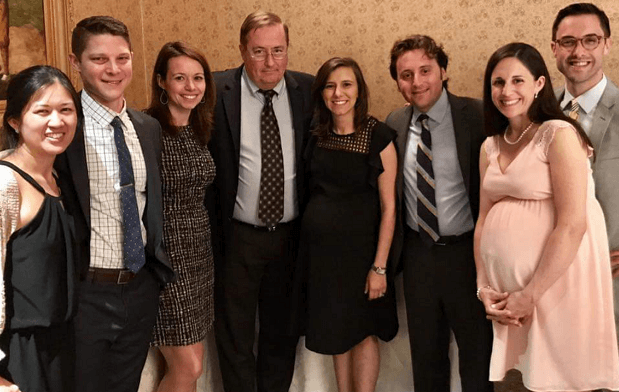He’s leaving, on a jet plane. Something tells us he’ll be back again. Oh Scott, we hate to see you go.
RMANJ fellow Dr. Scott Morin will complete his fellowship at the end of June, heading back to his home state of California for his next big adventure: opening up a brand new RMA office in downtown San Francisco and serving patients as one of the founding physicians.
His ‘graduation’ is bittersweet – while he is returning home and tackling an exciting challenge to open a new clinic in a highly-innovative market in the heart of San Francisco’s technology hub, he is leaving behind a close-knit group of fellows, nurses and doctors from whom he’s learned, with whom he’s penned research and about whom he’ll never forget.
“Every day is a gift here,” Dr. Morin said. “My goal is to take what I learned here and apply it on the West Coast.”
His clinic, RMA of Northern California, is slated to open by year’s end, capping off a whirlwind experience in the field of infertility that began when Dr. Morin was a just a boy.
In those years, growing up in California, Dr. Morin spent a lot of time in the hospital. But he wasn’t sick – his father was an OB-GYN and delivered babies (including, ironically enough, Dr. Morin’s future wife).
That early education was formative, leading Dr. Morin to pursue medical school. He soon realized that studying one particular discipline felt more like pleasure than work – and that was reproductive medicine.
“It was fascinating,” he said. “I found myself reading about it outside of normal course work.”
Initially interested in being a high-risk pregnancy doctor, he ultimately decided on reproductive endocrinology because it allowed him to get involved at the very beginning of the fertility journey, just as people began planning their families.
“I think families are such beautiful things,” he said. “It’s such a selfless endeavor to want to raise a child and build your family, so it’s extremely powerful when you can help these people who want to be parents achieve their goal.”

“The transition into fertility medicine happened very naturally.”
So did his arrival three years ago at RMANJ. During his residency, he kept reading about the translational research done here, and he realized there was no better place to master the science and practice of infertility than here.
“Everything I was reading had already been done or was done better at RMA,” Dr. Morin said. “It was so undeniable that this was the best place in the world to do my fellowship.”
“I couldn’t pass it up.”
He wasted no time upon his arrival in Basking Ridge from New York University, where he did his residency. He dove into research, including the ongoing LO2 study, meant to discover whether oxygen levels in the embryo culture should fluctuate between 2% and 5% in the first five days of growth or maintain a 5% oxygen concentration throughout that time.
The premise is simple: research has shown that oxygen concentrations inside the fallopian tube from day one to three of embryo growth during natural conception is about 5 per cent, and RMANJ’s embryology lab has fertilized and grown embryos until day three at this percentage. However, research has also shown that the oxygen concentration in the uterus, the home of the embryo after day three, is 2 per cent, leaving Dr. Morin wondering whether embryo culture after day three should be dropped to 2 per cent oxygen.
His study looks at just this – half of the participants will have embryos start off in 5 per cent oxygen concentration and move to 2 per cent on day three, while the other half will have embryos stay at 5 per cent after day three. Embryos from both groups will then be biopsied on day five or six and then transferred.
“The preliminary research suggests more embryos are surviving when they are in 2 per cent oxygen culture after day three, so we’re trying to see if that also translates into more pregnancies and live births,” Dr. Morin explained. “We’ll be compiling our findings in about a year.”
In a year Dr. Morin will already be six months into his role at his own RMA clinic, and several new fellows will be walking his old halls in Basking Ridge, embarking on new research and making history, just as he did.
“If I had to tell the incoming fellows one thing, it would be to take their time to consider how they want to spend every day, because there is such a wealth of experience and opportunity here,” he said. “It takes time to get the lay of the land, and once you do, you really immerse yourself – so choose wisely.”




